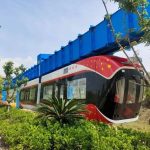In 2021, the share of urban rail transit passenger volume in the total public transport passenger volume will reach 43.4%, an increase of 4.7 percentage points over the previous year. Among the 50 cities in China that have opened urban rail transit, Shanghai, Guangzhou, Shenzhen, Chengdu, Nanjing, Beijing, Hangzhou and Nanning are eight cities, and this data has exceeded 50%.
Behind the ever-increasing public transport sharing ratio is an increasingly large operating volume. By the end of last year, the total length of China’s urban rail operating lines had further approached the 10,000-kilometer mark, reaching 9,206.8 kilometers; the average daily passenger volume exceeded 67 million.
At the same time, the profit and loss status of subway companies in various cities has been closely watched.
In the past few years, Shenzhen Metro has always been “outstanding” with a profit of more than 10 billion yuan, and its profit even exceeded the sum of the net profits of more than 20 urban subway companies.
However, as companies successively release their latest financial reports for 2021, this pattern has quietly changed.

1
Guangshenhang’s net profit “shrinks”
At present, subway companies in 21 cities have announced their annual reports for 2021 (the names of urban rail transit companies in different cities are slightly different, and they are all referred to as “subway companies” in the text, the same below). Compared with last year, Fuzhou, Changzhou, etc. were added, and the annual data of Zhengzhou, Shenyang, Xi’an, Changchun and other subway companies have not yet been released.
According to the latest data, among the 21 metro companies, the net profit data of 16 cities has increased compared with the previous year. The top five subway companies by net profit are from Shenzhen, Wuhan, Nanchang, Chengdu and Tianjin. Among them, Shenzhen Metro is still the most profitable in China, with a net profit of about 2.89 billion yuan, but this figure has shrunk significantly compared with previous years.
In 2020, Shenzhen Metro’s net profit is as high as 11.102 billion yuan, which is close to 1.7 times the sum of the net profits of the other 20 cities that year, and nearly 4 times its own net profit in 2021; in 2019, this figure is as high as 11.667 billion yuan. Among the 22 cities released by the Shangqing that year, the net profit of Wuhan, which ranked second, was 1.565 billion yuan, which was not even a fraction of that of Shenzhen.
Guangzhou also experienced a similar decline. In 2020, the profit of Guangzhou Metro dropped sharply by about 78% to 230 million yuan, directly from 1.044 billion yuan the previous year. In 2021, its profit rebounded slightly to 352 million yuan, but the decline from the data in 2019 is still obvious.
Hangzhou’s net profit in the past two years has dropped more significantly. In 2019, its profit was 1.265 billion yuan, ranking high in China; in 2020, Hangzhou’s net profit changed from positive to negative to -1.162 billion yuan; according to the latest data, although the loss of Hangzhou Metro has narrowed, it is still negative. (-253 million yuan).
In contrast, the profits of subway companies in many cities have increased significantly in the past two years.
For example, Wuhan’s net profit will increase by about 100 million yuan per year, from 1.565 billion yuan in 2019 and 1.668 billion yuan in 2020 to 1.769 billion yuan in 2021. The latest net profit of Nanchang Rail Transit Group recorded 1.669 billion yuan, more than twice that of 2019 and more than three times that of 2020.
In addition, there are two other cities, and the profit in the past two years can be described as a staged leap compared with the previous one.
One is Ningbo. In 2019, Ningbo Rail Transit Group’s revenue and expenditure were basically balanced, with a net profit of only 23 million yuan. In the past two years, its net profit has risen sharply to nearly 800 million yuan in 2020 and nearly 500 million yuan in 2021;
The second is Chengdu. In 2019, its net profit was also only 86 million yuan. By 2020, it will directly jump to 1.476 billion yuan, an increase of more than 16 times. The latest data shows that Chengdu Rail Transit Group has maintained a profit of nearly 1 billion yuan, with a net profit of 953 million yuan.

2
17 City operating costs increased
In fact, most subway companies’ operating costs will increase in 2021.
Among the 21 cities, only Shenzhen, Chengdu, Tianjin, and Ningbo saw their operating costs (excluding taxes, etc., the same below) decrease, and the operating costs of the remaining 17 cities increased compared with the previous year. Among them, Changzhou subway operating costs increased by nearly 400%, Lanzhou increased by more than 270%, Qingdao increased by 164%, and Nanchang increased by 104.5%.
The operating cost of urban rail transit can be roughly divided into variable cost and fixed cost. The variable cost is closely related to the number of kilometers traveled by the vehicle, the most important being traction energy consumption, vehicle maintenance costs, etc.; the fixed cost mainly includes labor cost, some ongoing maintenance and management fees.
The data shows that the two cities with the most significant decline in energy consumption per person-kilometer in 2021 are Jinan and Qingdao where urban rail transit accelerated to become a network last year and passenger turnover increased significantly.
Jinan’s Line 2, which opened in March 2021, will connect the independent Lines 1 and 3 in series, and two vertical lines and one horizontal line will initially form a network. The resulting passenger flow agglomeration effect is prominent.
According to data from the China Urban Rail Transit Association, its passenger turnover has increased from 59.85 million person-kilometers in 2019 and 68.2 million person-time kilometers in 2020, to 541 million person-time kilometers in 2021. Its passenger traffic volume increased by 693% year-on-year, and the traction energy consumption per passenger kilometer decreased by 77% year-on-year.
Qingdao’s cross-sea Metro Line 1, which was completed in December last year, successfully connected Line 13 to the main urban network. Its passenger turnover has also doubled from 1,668.57 million person-kilometers and 1,195.15 million person-time kilometers in the previous two years to 2,382.01 million person-time kilometers in 2021, and the traction energy consumption per passenger-kilometer has dropped by 27% year-on-year.
3
Relying on subsidies to “turn losses into profits”?
Data from as early as 2020 showed that among the 18 subway companies whose financial reports listed operating or ticketing revenue, 14 had operating/ticketing revenue accounting for less than 50% of their operating revenue.
Under this circumstance, the “government subsidy” income of some subway companies is still rising year by year.
Among the 21 subway companies that have released data in 2021, a total of 7 companies listed the amount of government subsidies in their non-operating income.
Among them, Guangzhou, where the decline was obvious, dropped from about 3.25 million yuan in 2020 to nearly 1.2 million yuan in 2021. On the contrary, the government subsidy received by Tianjin has risen for three consecutive years, from 1.24 billion yuan, 1.55 billion yuan, all the way to 1.71 billion yuan in 2021.


